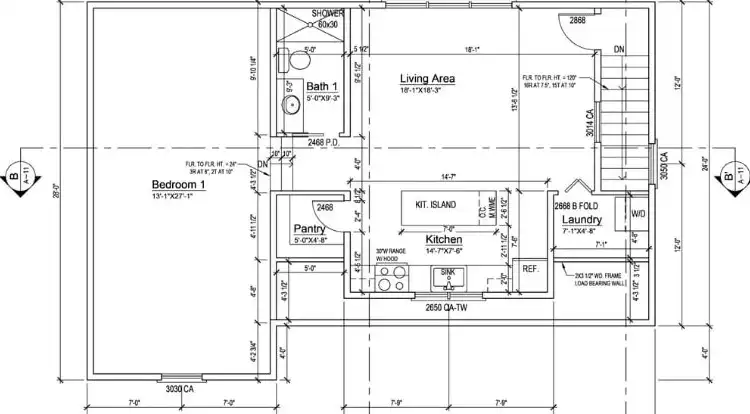Construction projects are complex endeavors where precision matters at every stage. From initial planning to final handover, accuracy can make the difference between a successful project and a costly disaster. Yet one critical aspect often gets overlooked until problems arise: as-built documentation.
When construction wraps up, what you see isn’t always what you get. Changes happen during construction—pipes get rerouted, walls shift slightly from original plans, and electrical systems take different paths than initially designed. Without accurate as-built services to capture these real-world conditions, you’re setting yourself up for expensive surprises down the road.
This comprehensive guide to as-built services will show you why investing in accurate documentation isn’t just smart—it’s essential for construction success. Whether you’re a project manager, facility owner, or construction professional, understanding the value of precise as-built modeling services can save you time, money, and headaches for years to come.
What are As-Built Services?
As-built services encompass the comprehensive documentation of a structure’s actual conditions after construction completion. Unlike original design drawings that show what was planned, as-built documentation captures what was actually built.
These services typically include three main components: as-built surveys, drawings, and 3D models. As-built surveys involve precise measurements of the completed structure using advanced tools like laser scanners and total stations. The data collected creates detailed drawings showing exact locations of walls, utilities, equipment, and other building components. Modern as-built modeling services go a step further by creating three-dimensional digital representations that provide immersive views of the finished project.
The scope of as-built documentation varies depending on project needs. Some projects require basic floor plans showing room layouts and dimensions. Others need comprehensive documentation including mechanical, electrical, and plumbing (MEP) systems, structural elements, and even underground utilities. The level of detail captured depends on the building’s complexity and intended use of the documentation.
Professional as-built services employ various technologies to ensure accuracy. Traditional methods relied heavily on manual measurements using tape measures and basic surveying equipment. Today’s services leverage cutting-edge tools like 3D laser scanning, photogrammetry, and drone imagery to capture millions of data points with millimeter precision.
Benefits of Accurate As-Builts
Improved Project Planning
Accurate as-built documentation serves as the foundation for future projects involving existing structures. When planning renovations, additions, or system upgrades, having precise measurements eliminates guesswork and reduces planning time significantly.
Consider a hospital planning to upgrade its HVAC system. With accurate as-built models showing exact locations of existing ductwork, electrical conduits, and structural elements, engineers can design new systems that integrate seamlessly with existing infrastructure. This level of precision prevents conflicts during construction and ensures optimal system performance.
The planning benefits extend beyond major renovations. Maintenance teams use as-built documentation to locate utilities, plan equipment replacements, and coordinate repairs. Instead of spending hours searching for buried pipes or hidden electrical lines, technicians can reference accurate drawings to work efficiently and safely.
Reduced Rework and Cost Overruns
Construction rework represents one of the industry’s most significant cost drivers. Studies show that rework can account for 5-20% of total project costs, with much of this waste stemming from inaccurate or missing documentation.
Accurate as-built services help prevent costly surprises during future construction phases. When contractors know exactly where existing utilities run, they can avoid accidental damage that leads to expensive repairs and project delays. This is particularly critical in renovation projects where hidden infrastructure poses constant risks.
The cost savings compound over time. A manufacturing facility with accurate as-built documentation can plan equipment installations more efficiently, reducing downtime and installation costs. The upfront investment in quality as-built services typically pays for itself within the first major project that references the documentation.
Enhanced Facility Management
Modern facility management relies heavily on accurate building data to operate efficiently. As-built documentation provides facility managers with the detailed information they need to maintain systems, plan space utilization, and respond to emergencies effectively.
Energy management becomes more precise when facility managers know exact equipment locations, system specifications, and spatial relationships. This information enables targeted maintenance programs that extend equipment life and reduce energy consumption. Smart building technologies also benefit from accurate baseline data to optimize performance algorithms.
Emergency response improves dramatically with accurate as-built documentation. First responders can quickly locate utilities, exits, and hazardous materials using detailed floor plans and 3D models. This capability can literally save lives during critical situations.
Challenges of Traditional As-Built Processes
Traditional as-built documentation methods present numerous challenges that can compromise accuracy and project timelines. Manual measurement techniques, while familiar to many professionals, are inherently time-consuming and error-prone.
Field teams using traditional methods must visit sites multiple times to capture all necessary measurements. Each visit involves significant labor costs and potential safety risks, especially in active construction environments or industrial facilities. Weather conditions, site access restrictions, and coordination with ongoing operations further complicate the process.
Human error represents another significant challenge. Manual measurements can introduce cumulative errors that become apparent only when systems don’t fit as expected. Transcription errors, misread measurements, and inconsistent documentation standards all contribute to inaccuracies that create problems later.
Older documentation methods also struggle with complex geometries and hard-to-reach areas. Measuring curved surfaces, high ceilings, or areas with limited access requires specialized equipment and techniques that traditional methods can’t always provide. This limitation often results in incomplete documentation that leaves gaps in critical information.
Time constraints frequently force compromises in traditional as-built processes. Project schedules rarely allow sufficient time for comprehensive manual documentation, leading to abbreviated surveys that miss important details. These shortcuts seem cost-effective initially but often prove expensive when information gaps cause problems during future projects.
Modern Solutions: Advanced As-Built Technologies
Technology has revolutionized as-built services, making accurate documentation faster, safer, and more comprehensive than ever before. 3D laser scanning leads this technological transformation by capturing millions of precise measurements in minutes rather than days.
Laser scanning technology creates detailed point clouds that represent every visible surface within the scanning range. These point clouds serve as the foundation for creating accurate as-built drawings and 3D models. The precision of modern scanners reaches sub-millimeter accuracy, far exceeding what manual methods can achieve.
Drone technology has expanded the possibilities for as-built documentation, particularly for large sites and areas with challenging access. Drones equipped with high-resolution cameras and LiDAR sensors can capture roof conditions, facade details, and site layouts safely and efficiently. This aerial perspective provides valuable context that ground-based methods might miss.
Photogrammetry represents another powerful tool in modern as-built services. This technique uses overlapping photographs to create accurate 3D models and measurements. When combined with laser scanning data, photogrammetry can fill gaps and provide visual context that enhances the usability of as-built documentation.
Building Information Modeling (BIM) integration has transformed how as-built data gets used. Modern as-built modeling services create BIM-compatible models that integrate seamlessly with design software. This compatibility enables architects and engineers to work directly with as-built data, improving accuracy and efficiency throughout the design process.
Mobile scanning platforms are making as-built services more accessible and cost-effective. Handheld scanners and smartphone-based measurement apps bring professional-grade capabilities to smaller projects that previously couldn’t justify traditional surveying costs.
Choosing the Right As-Built Service Provider
Selecting the appropriate as-built service provider, such as Chudasama Outsourcing, requires careful consideration of several key factors. Experience with similar project types should top your evaluation criteria, as different building types present unique challenges that experienced providers like Chudasama Outsourcing understand and anticipate.
Technology capabilities vary significantly among service providers. Leading companies like Chudasama Outsourcing invest in the latest scanning equipment, software platforms, and processing capabilities. Ask potential providers about their equipment specifications, update schedules, and quality control procedures to ensure they can deliver the precision your project requires.
Deliverable formats matter more than many clients initially realize. Chudasama Outsourcing ensures as-built documentation is delivered in formats that match your team’s software and workflow requirements. Compatibility with major CAD and BIM platforms is essential for maximizing the value of your investment.
Turnaround time and project scheduling flexibility often determine project success. Discuss your timeline requirements upfront and understand how the provider manages project scheduling. Chudasama Outsourcing offers both expedited services for time-critical projects and expertise in large-scale projects requiring extended fieldwork periods.
Quality assurance processes separate professional providers like Chudasama Outsourcing from those offering basic services. Reputable companies implement multi-stage quality checks, accuracy verification procedures, and client review processes to ensure deliverables meet specifications. Ask about their quality standards and accuracy guarantees.
Professional certifications and insurance coverage protect your interests and indicate provider credibility. Look for providers like Chudasama Outsourcing with relevant surveying licenses, professional certifications, and comprehensive insurance coverage that includes errors and omissions protection..
Maximizing Your As-Built Investment
Accurate as-built services represent far more than a project deliverable—they’re an investment in your facility’s future operational efficiency and cost management. The true value emerges over time as the documentation supports countless decisions, projects, and operational activities.
Smart organizations treat as-built documentation as living documents that require periodic updates. Building modifications, equipment changes, and system upgrades should trigger documentation updates to maintain accuracy. Establishing update procedures during the initial as-built project ensures long-term value preservation.
Training your team to effectively use as-built documentation multiplies its value. Facility managers, maintenance technicians, and project managers all benefit from understanding how to access and interpret the documentation. Many service providers offer training programs to help clients maximize their investment.
The construction industry continues evolving toward data-driven decision making and digital workflows. Accurate as-built services position your organization to capitalize on these trends while avoiding the costs and delays that plague projects lacking proper documentation. The question isn’t whether you can afford to invest in quality as-built services—it’s whether you can afford not to.




